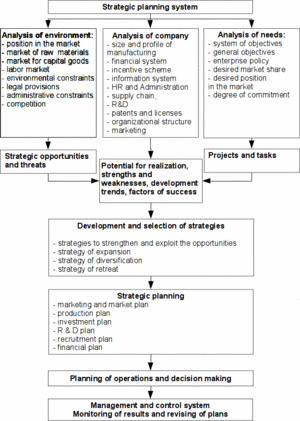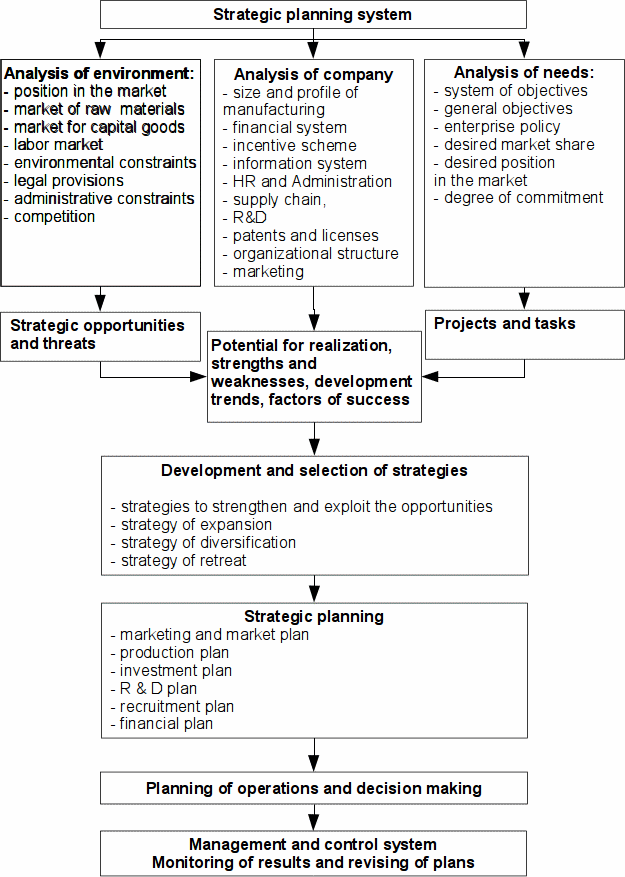Strategizing
| Strategizing |
|---|
| See also |
Strategizing includes all practical actions performed by people to devise long-term goals (mission, vision), plans (strategies), course of action (processes, structures). Strategizing is very common in industry, business, military, politics and government. Strategizing is strongly connected to strategic thinking. Managers should think strategically of all important areas of company development to achieve long term objectives and success.
Strategizing as a planning process
Strategic planning processes is first in a sequence of strategic management whose goal is to introduce and implement the best strategy for the company. Diagram of this process is shown in the figure below. The starting point of for mangers during strategize session involves preparing company mission and vision. Vision consist of short saying (few words) describing future of the company (image created in heads of managers), which should contain the following elements:.
- description of the perceived environment of business,
- strategic domain (industry in which managers wants to perform business),
- description of the key competences now and in the future,
- course of action to the place described in vision.
Main tasks in strategizing

Fig. 1. Strategizing as planning process in the company
The main tasks in strategizing include:
- Setting goals and objectives: The first step in strategizing is to clearly define what you want to achieve. This includes identifying specific, measurable, and achievable goals and objectives that align with the overall mission and vision of the organization.
- Assessing the current situation: The next step is to analyze the current situation, including internal and external factors that may impact the organization's ability to achieve its goals. This includes evaluating the organization's strengths, weaknesses, opportunities, and threats.
- Evaluating options: After analyzing the current situation, the next step is to evaluate different options for achieving the goals and objectives. This includes assessing the feasibility, cost, and potential risks and benefits of each option.
- Developing and implementing a plan of action: Once the best course of action is identified, the next step is to develop a detailed plan that outlines the specific steps needed to achieve the goals and objectives. This includes identifying resources, timelines, and performance indicators.
- Monitoring and adapting the plan: The final step is to monitor and evaluate the progress of the plan and make adjustments as needed. This includes tracking performance indicators and making changes to the plan as needed to ensure that the organization stays on track to achieve its goals.
It's worth noting that strategizing also includes a continuous process of reviewing and updating the plan, as the environment, organization, and goals may change over time.
Strategizing and decision-making and strategic thinking
Decision-making and strategic thinking are closely related concepts that are essential to the process of strategizing. Decision-making is the process of choosing among different options based on their potential benefits and drawbacks. It is an essential step in strategizing, as it allows individuals and organizations to select the best course of action to achieve their goals.
Strategic thinking, on the other hand, is the ability to think long-term and consider the big picture. It involves analyzing the current situation, identifying potential opportunities and threats, and thinking creatively about how to achieve goals. Strategic thinking is crucial for effective strategizing, as it allows individuals and organizations to develop and implement plans that are flexible and adaptable to changing circumstances.
Together, decision-making and strategic thinking are the key elements that allow individuals and organizations to make informed, effective decisions and achieve their goals. They are the foundation of effective strategizing, as they help individuals and organizations to identify the best course of action and execute it successfully.
The role of strategizing
Strategizing should be an integral part of the management of the company and, must take into account the limitations imposed by: conflicting interests, financial barriers, resource constraints, lack of information, strategic potential, lack of competence, the expected change in an environment, competition, etc.
Strategizing is important for a number of reasons:
- Achieving goals: Strategizing is a process of planning and organizing resources to achieve a specific goal or set of goals. By developing a clear strategy, individuals and organizations can identify what they want to achieve and the steps needed to get there.
- Long-term planning: Strategizing allows individuals and organizations to think long-term and consider the big picture. It helps them to identify potential opportunities and threats, and make decisions that will position them for success in the future.
- Adapting to change: Strategizing helps individuals and organizations to be flexible and adaptable to changing circumstances. By regularly reviewing and updating their strategies, they can respond quickly and effectively to new challenges and opportunities.
- Competitive advantage: Effective strategizing can give individuals and organizations a competitive advantage. By identifying and seizing opportunities, and effectively managing risks, they can differentiate themselves from their competitors and gain a foothold in the market.
- Effective use of resources: Strategizing helps individuals and organizations to make the most effective use of their resources. By identifying their goals and the resources needed to achieve them, they can ensure that their resources are allocated in the most efficient and effective way possible.
Strategizing is a vital process for achieving goals, planning for the future, adapting to change, and gaining a competitive advantage. It enables individuals and organizations to make informed decisions and use their resources effectively to achieve success.
Manager thinking strategically underscores practical perspective of strategic planning and organizational design. It is usually done by managerial elites having expertise and interests that strongly influence the nature of business strategy and organization. It should be noted, that strategizing is also performed by middle managers, management consultants, corporate planners, OD professionals, etc. Among those disparate classes of actors involved in strategic planning several strategic conversations takes place, which lead to common understanding and creation of unique corporate strategy. Because of this, high level of communication skill is needed during strategize session in every complex group of people.
References
- Jarzabkowski, P., Balogun, J., & Seidl, D. (2007). Strategizing: The challenges of a practice perspective. Human relations, 60(1), 5-27.
- Johnson, G., Melin, L., & Whittington, R. (2003). Micro strategy and strategizing: towards an activity‐based view. Journal of management studies, 40(1), 3-22.
- Williamson, O. E. (1991). Strategizing, economizing, and economic organization. Strategic management journal, 12(S2), 75-94.
- Whittington, R. (2003). The work of strategizing and organizing: for a practice perspective. Strategic organization, 1(1), 117-126.
Author: Krzysztof Wozniak

